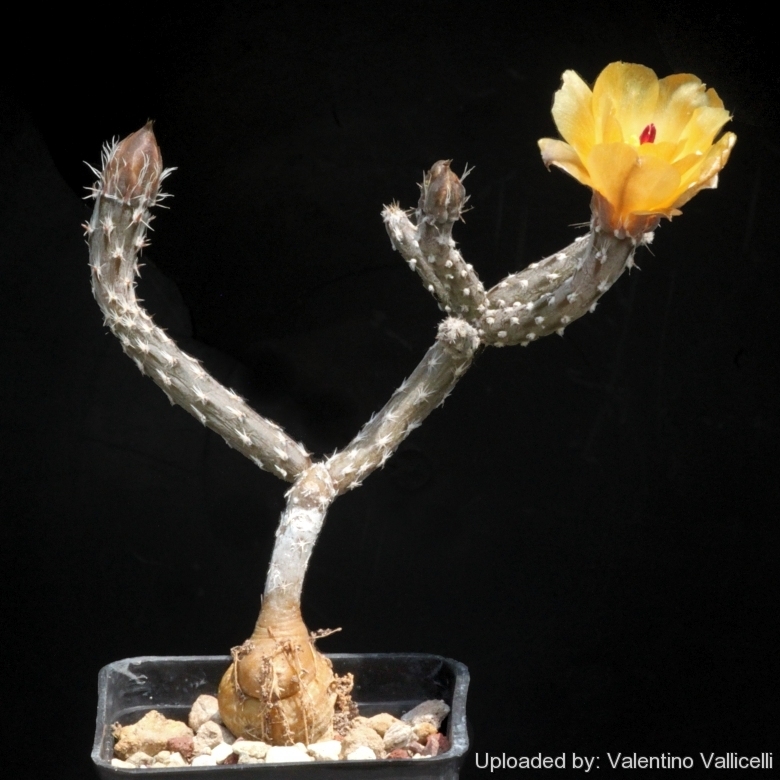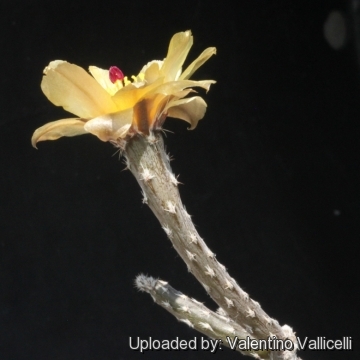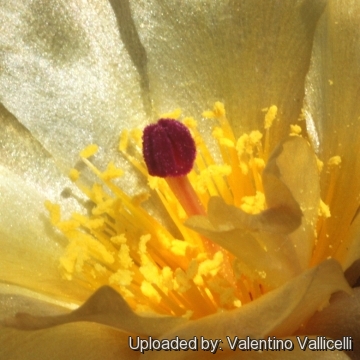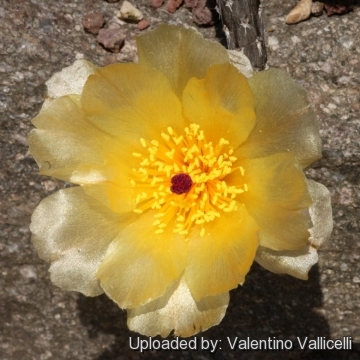= Pterocactus kuntzei K.Schum.
Monatsschr. Kakteenk. 7: 6, pl. 1897
Accepted Scientific Name: Pterocactus tuberosus (Pfeiff.) Britton & Rose
Cactaceae (Britton & Rose) 1: 32. 1919 [21 Jun 1919] Britton & Rose

Opuntia kuntzei (Pterocactus kuntzei) Photo by: Valentino Vallicelli
Origin and Habitat: Northern Argentina from Rio Negro in the south to Salta in the north and Patagonia.
Ecology: This plant has a peculiar reproductive mechanism: they have the ability to lose their sprouts in autumn and winter. These are then spread by strong winds and volatile sands, and can give origins to new plants in the next vegetative season. The tuberose roots will grow new floriferous stems again.
Synonyms:
See all synonyms of Pterocactus tuberosus
back
Accepted name in llifle Database:Pterocactus tuberosus (Pfeiff.) Britton & RoseCactaceae (Britton & Rose) 1: 32. 1919 [21 Jun 1919]Synonymy: 8
back
Description: Pterocactus kuntzeiSN|1128]]SN|1130]] is a geophyte cactus with gorgeous tuberous rootstock under the soil with many caducous cylindrical branches. It is often catalogued as a caudiciform and when it is potted up, the plant can be progressively raised over the ground so that some of the roots can be seen and is especially cultivated for their looks. Architecturally it is a real stunner. When the "caudex" shape of the raised roots is adequately in evidence this plant is incomparable.
Stems: Thin, cylindrical, fragile, erect to pendulous, 3 to 40 cm long, dark brownish-purple that breaks off easily. New stems arise both from the top of the rootstock and also around the edges of the end of the terminal flower stems.
Root: It has a tuberous root system , up to 8 cm thick, deeply set in the ground, that in cultivation can fill a 20 cm diameter pot.
Flowers: Pare a pale to deep silky yellow and the stigma can go from almost white, to pink or to deep red. The flowers are produced from the apex of new growth.
Remarks: Now this taxa has been synonymized with Pterocactus tuberosusSN|1126]]SN|1126]] & Pterocactus decipiensSN|1130]]SN|1128]].
Subspecies, varieties, forms and cultivars of plants belonging to the Pterocactus tuberosus group
Bibliography: Major references and further lectures
1) Nathaniel Lord Britton, Joseph Nelson Rose “Cactaceae: Descriptions and Illustrations of Plants of the Cactus Family” Courier Dover Publications, 1963
2) Edward Anderson “The Cactus family” Timber Press, Incorporated, 2001
3) James Cullen, Sabina G. Knees, H. Suzanne Cubey "The European Garden Flora Flowering Plants: A Manual for the Identification of Plants Cultivated in Europe, Both Out-of-Doors and Under Glass" Cambridge University Press, 11/Aug/2011
4) David R Hunt; Nigel P Taylor; Graham Charles; International Cactaceae Systematics Group. "The New Cactus Lexicon" dh books, 2006
5) Haustein, Erik “Der Kosmos-Kakteenführer” Kosmos (franckh-kosmos) 1998 ISBN: 3440076857
6) Edgar Lamb, Brian Lamb “The Illustrated Reference on Cacti & Other Succulents” Volume 5 Blandford Press, 1978
7) John Borg “Cacti: a gardener's handbook for their identification and cultivation” Blandford P., 1970
 Opuntia kuntzei (Pterocactus kuntzei) Photo by: Valentino Vallicelli
Opuntia kuntzei (Pterocactus kuntzei) Photo by: Valentino Vallicelli Opuntia kuntzei (Pterocactus kuntzei) Photo by: Valentino Vallicelli
Opuntia kuntzei (Pterocactus kuntzei) Photo by: Valentino Vallicelli Opuntia kuntzei (Pterocactus kuntzei) Photo by: Valentino Vallicelli
Opuntia kuntzei (Pterocactus kuntzei) Photo by: Valentino VallicelliSend a photo of this plant.The gallery now contains thousands of pictures, however it is possible to do even more. We are, of course, seeking photos of species not yet shown in the gallery but not only that, we are also looking for better pictures than those already present.
Read More... Cultivation and Propagation: Pterocactus tuberosusSN|1126]]SN|1126]] is easy to grow, provided it is kept cool, but dry during autumn and winter. It is a particular favourite of caudiciform plant enthusiasts.
Growth rate: Plants grow very slowly and caudex take many years to enlarge. Clustering in cultivation, if grown correctly, it will reward the grower with generous displays of flowers.
Caudex exposure: The remarkable tuberous rootstock (caudex) is often raised above the soil line so that this can be seen and more readily appreciated. For best results the tuber must be exposed only when plans become mature enough, usually after several years of underground growth, as the exposed caudex will no longer increase in size once it has been lifted above the soil line.
Potting medium: Use a cactus mix or add extra perlite or pumice to regular soil potting soil. A gritty, very free-draining compost is suitable, and clay pots help the plants to dry out between watering. For best results, use a deep pot.
Fertilization: Need a perfect fertilizer diet in summer. Use preferably a cacti and succulents fertilizer with high potassium content including all micro nutrients and trace elements or slow release fertilizer.
Watering Needs: Water normally in the growing season from March to October. No water should ever be allowed to stand around the roots. Keep almost completely dry in winter. The swollen caudex makes it very tolerant of under watering.
Hardiness: It is quite frost resistant if kept dry, hardy as low as -15° C. It can be grown outdoors in the summer months to benefit from direct exposure to light, and especially exposure to high summer temperatures. Recommended Temperature Zone: USDA 9-10.
Sun Exposure: It is essential to give full sun; otherwise they will become atypical. If grown in full sun, the new growth will flower profusely in spring and summer.
Rot: Rot it is only a minor problem with pterocacti if the plants are watered and “aired” correctly. If they are not, fungicides won't help all that much. The plant turns immediately to mush when over watered, or watered out of season. Care must be given in watering, keeping them warm and wet while growing, and cooler and dry when dormant.
Maintenance: Most of the slender stems become detached during winter, but some advise to help the plant by pruning all the top growth in autumn, to encourage it to produce stems with terminal flowers in the spring.
Grafting stock: Pterocactus tuberosusSN|1126]]SN|1126]] tuber is sometime used as an hardy grafting stock for south-American cacti like Tephrocactus malyanusSN|4175]]SN|4175]]. The flat graft system is usually adopted when using a stock of this type, and it is far better than Pereskia.
Reproduction: Seeds or cuttings. The seed should be planted in spring. Germination usually occurs within about one week to one month. Seed germinate at 15-21 °C.













